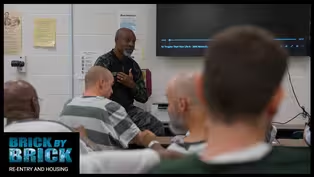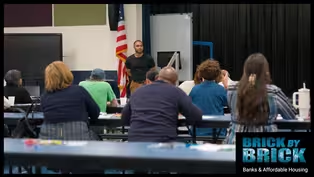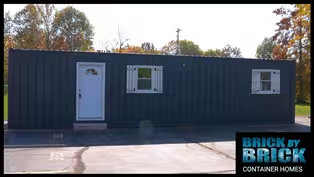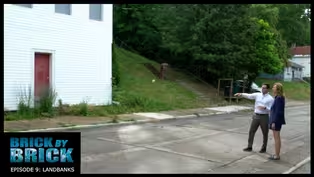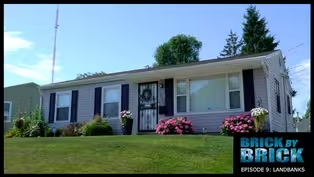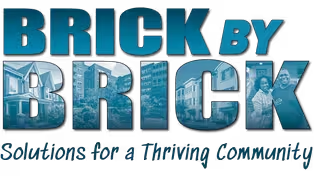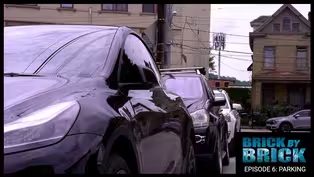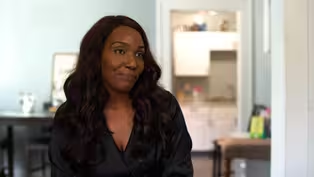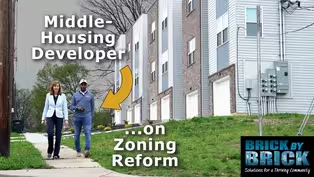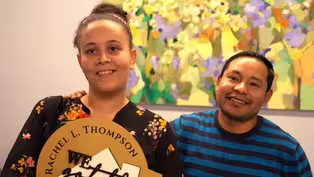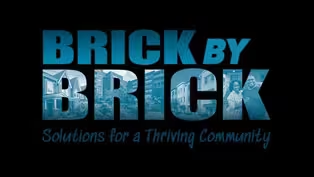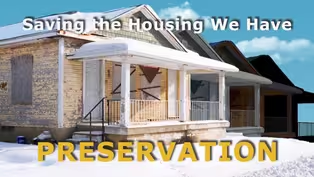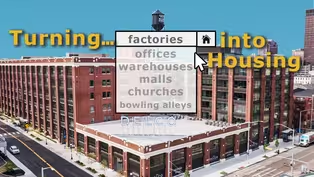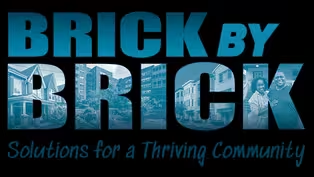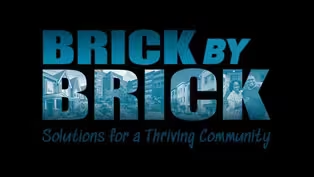
A Housing Solution Right in our Backyard
Clip: Season 1 | 6m 34sVideo has Closed Captions
Two Cincinnati residents share their experience building an accessory dwelling unit.
With the shortage of housing in the U.S. accessory dwelling units may help fill a housing gap and many cities in our area are beginning to relax their zoning laws. Two Cincinnati residents share their experiences building one in their backyard.
Problems playing video? | Closed Captioning Feedback
Problems playing video? | Closed Captioning Feedback
Brick by Brick is a local public television program presented by CET

A Housing Solution Right in our Backyard
Clip: Season 1 | 6m 34sVideo has Closed Captions
With the shortage of housing in the U.S. accessory dwelling units may help fill a housing gap and many cities in our area are beginning to relax their zoning laws. Two Cincinnati residents share their experiences building one in their backyard.
Problems playing video? | Closed Captioning Feedback
How to Watch Brick by Brick
Brick by Brick is available to stream on pbs.org and the free PBS App, available on iPhone, Apple TV, Android TV, Android smartphones, Amazon Fire TV, Amazon Fire Tablet, Roku, Samsung Smart TV, and Vizio.
Providing Support for PBS.org
Learn Moreabout PBS online sponsorship- We were wondering about the human aspect in all of this.
Who amongst our neighbors would want an A DU and for what particular use would they use it?
We welcome Brick by Bricks.
Amaco more to the studio.
Hi Amaco.
- Hi Anne - Amaco.
You tracked down a couple of backyard Cottage owners.
- Yes.
We found two people in Cincinnati who built backyard cottages for very different purposes.
And we know there are a few different uses.
That's true.
One built it for rental income and the other to provide housing for an aging parent.
Let's take a listen.
The state stately Victorian home isn't the only home on the West End property tucked behind the swimming pool.
In the backyard is an A DU that Dallas and Harriet Harrington live in.
You.
- You are sharing the space naturally.
You know, you are really sharing the - Space.
I don't know, I sort have a mortar feeling of safety because it's not just us here, you know, there's, there's other people around and there's a pool.
- The Harrington's moved back to Cincinnati after many years, saw the benefits of living in a backyard cottage and knew the owner Gerald Bates.
- So when we designed the exterior of the building, we tried to do something that would match the house.
- Bates finished his new A DU just three months ago.
- It has an open floor plan, so an open living dining kitchen area, a bath and a bedroom on one level, and then on the loft level it has another open space and a bathroom.
- And while he was working on it, there was plenty of interest.
- People would come by and they'd say, is, are you gonna be renting that?
And I said, yeah.
They said, oh, we'd be really interested - With rents going up and a shortage of housing.
Bates saw the advantages of renting out an A DU in his backyard.
He worked with a historic board, but had some back and forth with the city on design and material choices.
- I kind of objected and then I thought about it and I said, you know what, that's fine.
So we went ahead and that's the trade off.
- Bates invested a few hundred thousand to build his carriage house, adding one third to the value of his property and rental income to cover costs.
- You know, we just have enjoyed having tenants and they have their privacy and we have ours.
- But not all backyard cottages are as elaborate.
Others are more practical.
Like Sandy Hamilton's in the north side neighborhood of Cincinnati, 90 years ago, she needed a place for her 90-year-old mother to stay who was having trouble taking care of herself.
- She just was so happy that she was only gonna be a few doors from where she lived.
A few doors from McKee Recreation Center, a few doors from her church a block and a half away.
And many of her friends, you walk inside the door, there are no steps.
It's her dining and kitchen area.
Also a washer and dryer, a little visiting area.
And her bed was at the end of the room of the wet room is think it's about 10 by 12.
So had she ever gone into a wheelchair, she still could have fully functioned.
- Hamilton was able to build this A DU because she had a second lot.
But what she didn't have initially was permission from the city.
And that took a year.
- It wasn't a very friendly experience.
- ADUs weren't legal at the time.
- They wanted mom to have a driveway off of Hamilton.
Well, to have a cut through on a major street is extremely expensive, much more than this side street.
And also my mom never drove in her life, so there was no reason to have a driveway.
- But her persistence paid off.
And six months after getting the permits, she built the accessory apartment.
It - Was about a hundred dollars a square foot and the, it's 480 square feet on the first floor - According to a A RP.
79% of older adults want to age in their community and the need for safe and accessible senior housing is growing at a rapid pace.
In 2034, there will be more people over 65 than under 18.
- I found it very reasonable, especially compared with retirement facilities in that although my mom had some assets, she probably had, she lived a lot longer.
She probably would've gone through those assets at a nursing home - While her mother passed away in 2021, Hamilton sees ADUs as a godsend for many adaptable over time, they can offer housing for a young family, a caregiver, or provide rental income.
As in Bates's case, - Well, having renters helps to offset the cost of owning the building.
Even though even if you don't have a mortgage, you still have basic maintenance, upkeep, utilities, - And can fulfill various needs in a community.
I - Think it will be a tremendous opportunity to care for parents or a widowed parent, a aunt or a grandmother, even a disabled child that might have a live-in caretaker.
I think it's tremendous - Back in the studio now with Amaco.
Thanks for that.
You really did a good job pointing out the flexibility of ADUs.
They can be used for so many different things and I really like aging in place.
- Yes.
The A A RP is advocating for these smaller, more flexible housing units as a practical solution for our housing needs.
90% of the 50 plus population want to stay in their homes and communities as they age, where they have strong social networks and are familiar with the area.
And as in Gerald Bates's case, ADUs can make housing more affordable for both owner and renter.
- But it sounds like there were a few hurdles for both of them.
- Yes.
As you've been mentioning, ADUs were just legalized in Cincinnati last year.
So at the time it took Sandy Hamilton only six months to build her backyard cottage, but double that time, 12 months to get her permits approved.
And that is valuable time when you have an aging parent.
Bates took over three years to build because he was paying for construction out of pocket.
- But now Cincinnati fast forward has legalized them, so hopefully it will be easier.
I'm, I'm guessing.
Yes.
- Let's hope it does get easier.
- Thanks Amy Cove.
We'll catch up with you for the takeaways.
Can land trusts help provide affordable housing?
Video has Closed Captions
Clip: S1 | 6m 20s | Groups in Yellow Springs & Cincinnati, Ohio, use land trusts to make homes affordable. (6m 20s)
Is there a pathway to housing for the formerly incarcerated?
Video has Closed Captions
Clip: S1 | 6m 19s | A successful reentry into society depends on stable housing. (6m 19s)
Is Homeownership Right for Me?
Video has Closed Captions
Clip: S1 | 5m 44s | Banks & other organizations help Dayton residents figure out a path to homeownership. (5m 44s)
Container Homes: A Possible Solution for Affordable Housing
Video has Closed Captions
Clip: S1 | 4m 32s | Shipping containers are being transformed to provide housing. Can they be affordable? (4m 32s)
The Port's restoration process in Sedamsville is Underway
Video has Closed Captions
Clip: S1 | 3m 49s | Vice President of the Port gives us a walkthrough of the rehabbed homes in Sedamsville. (3m 49s)
The Montgomery Landbank Revitalizes homes in Pineview
Video has Closed Captions
Clip: S1 | 4m 15s | The Montgomery County Landbank helps stabilize the housing market with work in Pineview. (4m 15s)
A Housing Solution Right in our Backyard
Video has Closed Captions
Clip: S1 | 6m 34s | Two Cincinnati residents share their experience building an accessory dwelling unit. (6m 34s)
How Reducing Parking Minimums could Maximize the Opportunity
Video has Closed Captions
Clip: S1 | 7m 55s | Camp Washington navigates their paring and provides a test case for Cincinnati. (7m 55s)
Right to Counsel: Balancing the Courtroom
Video has Closed Captions
Clip: S1 | 8m 25s | A Dayton tenant details her experiences facing eviction with and without an attorney. (8m 25s)
Middle Housing Developer... on Cincinnati's Zoning Reforms
Video has Closed Captions
Clip: S1 | 4m 6s | As Cincinnati looks to change its zoning laws, one middle housing developer shows support. (4m 6s)
Zoning Reform Addressing the Invisible Barriers in the U.S.
Video has Closed Captions
Clip: S1 | 9m 16s | City planners from Tulsa, Buffalo, & Minneapolis detail their cities' zoning reform. (9m 16s)
Adaptive Reuse: The Barrister offers Affordable Housing
Video has Closed Captions
Clip: S1 | 9m | OTRCH and Urban Sites turn an office building into affordable apartments in Cincinnati. (9m)
Adaptive Reuse: The Grant Deneau Tower
Video has Closed Captions
Clip: S1 | 6m 32s | The Windsor Companies turns a mid-century modern office building into luxury apartments. (6m 32s)
Affordable Housing Solution: The Port's Approach
Video has Closed Captions
Clip: S1 | 10m 6s | A married couple and an army vet share their journey to finding affordable homeownership. (10m 6s)
Promo: Container Homes Solution
Video has Closed Captions
Preview: S1 Ep6 | 25s | They've been used for shipping, but can industrial containers also be a housing solution? (25s)
Video has Closed Captions
Preview: S1 Ep5 | 30s | Preview for the Brick by Brick team's upcoming episode on preservation in housing. (30s)
Video has Closed Captions
Preview: S1 Ep4 | 25s | Southwest Ohio is a leader in upcycling its buildings. Housing solution: adaptive reuse. (25s)
Promo: Housing Choice Vouchers Re-Examined (Promo)
Video has Closed Captions
Preview: S1 Ep2 | 30s | Re-examining the largest federal rental assistance solution. How well is it working? (30s)
Promo: Housing & Data Analytics (promo)
Video has Closed Captions
Preview: S1 Ep1 | 30s | The Brick by Brick team explores a new housing solution: preventative data analytics. (30s)
Providing Support for PBS.org
Learn Moreabout PBS online sponsorship
- News and Public Affairs

Top journalists deliver compelling original analysis of the hour's headlines.

- News and Public Affairs

FRONTLINE is investigative journalism that questions, explains and changes our world.
Urban Consulate Presents











Support for PBS provided by:
Brick by Brick is a local public television program presented by CET

